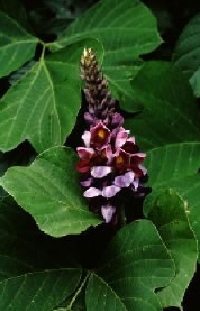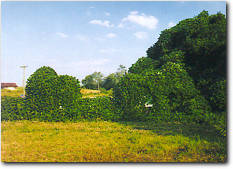about Kudzu
 kudzu bloom in the early autumn
kudzu bloom in the early autumn
The Kudzu plant, (a vine in the pulse family) can be seen every where in Japan; at the edge of the woods, on the river bank.
In spring and summer, it grows with frightful speed, extending nearly 50 cm per day. Because its root grows very deeply, kudzu has been used to reinforce steep banks.
Arrowroot flour is a starch which is made from kudzu roots, and is used for many Japanese foods. The dried roots are also used in herbal medicine, producing antipyretic (fever reducer) called "kakkonto" in Japanese.
Kudzu flowers are magenta and resemble wisteria flowers in the early autumn.
It is also called "Rising Wisteria" because the flowers turn up whereas wisterias' turns down.
Kudzu flowers smell wonderful.
Kudzu leaves contain a lot of starch and are quite suitable for livestock food. In certain districts, it is called "pig vine" or "horse cake", because animals love to eat it.
People use kudzu vine for baskets or ropes. A large basket for clothes called "Tsuzura" is made from kudzu vine. It is also used to make vine bridges.
Botanically kudzu is classified as a tree. It is a perennial, and each year its trunk becomes thicker.
It is not necessary for kudzu to form xylem, because it supports itself by clinging to other trees. The energy it saves can therefore be used to speed its growth; very clever behavior.
Kudzu propagates itself in two ways; one is growing roots from vine sections, and the other is to produce seeds which emerge after flowering.
It belongs to the pulse family and its seeds are contained in a sheath.
It was thought that the seeds were not capable of germination, but in fact, a sheath contains two types of seeds; one type of seed germinates immediately and the other that can take several years to several decades.
What a survival strategy!
We take fiber from the kudzu vine. It is usually used only for weft (not twisted), in Enshu, an area in the middle of Shizuoka Prefecture.
 kudzu in wikipediakudzu described in plant picture book Tomitaro Makino wrote
kudzu in wikipediakudzu described in plant picture book Tomitaro Makino wrote
Pueraria Thunbergiana Benth
Kudzu usually grow in mountains and wild fields and spread it's vine widely . It has perennial coiling vine. The core of vine becomes woods. It has brown rough hair on full of it's surface and coiling up quite widely even more than 10m.
It's leaves grow thick alternately and has green color ,rough hair sparsely . Whitely color and bristly white hair can be seen on the back of leaves.
In autumn it stand bunch flower 15~18cm length and bloom purple butterfly shaped flower.
It flowers sequentially from the under. Flower has 18~20mm length . Calyx has pale purple color.
Flower becomes fruit which has line shape and length is 5~10cm covered with rough brown hair.It' root grows very big and useful for medicine. Starch also can be taken with this roots. Leaves are useful for feeding of cattle.
Japanese name [kuzu] is an omission of [kuzukazura] in Japanese. There is a area named [kuzu]
in Nara prefecture. In ancient time people lived in Kuzu peddled kuzu starch . That's why kuzu was called kuzu.
kudzu in okinawa island in japan
kudzu in Okinawa island 2005There are two kinds of kudzu.One is Labota and the other is Montana. When I visited okinawa island october 2005, okinawa people bring kudzu to me. Clearly it was different from kudzu in Hondo island(Main island of Japan) I think it was Montana. It had long flower and small leaves rather compare with Hondo island kudzu labota
Long flower Okinawa island 2005I walked around North Nakagusuku village in Okinawa Oct. 2007 and found small group of Montana but could not find Labota.It seemed that they didn't have overwhelming fertility like the case in Hond island.
Kudzu Vine in the United States
 http://www.yahoolavista.com/kudzu/http://en.wikipedia.org/wiki/Kudzu
http://www.yahoolavista.com/kudzu/http://en.wikipedia.org/wiki/Kudzu
![]() kudzu in wikipedia
kudzu in wikipedia
■「300 million hectares of the United States are covered with the vine now. The plant that grows naturally is excluded, and land is depreciated. The use of a poisonous herbicide to exterminate it from both the country and the state as a harmful weed is examined. However, it is a thing of the herbicide that do not do and do not let the way done for the environment. Then, I want to use it as a resource that can use the vine. 」
letter from Beniko Takeda who was a student of North Carolina State University in January 2006
Growth and breeding of kudzu vine
■ Vegetative propagation
kudzu's seed fall on ground and some of them can grow successfully, but they don't have flower , so there is no seed. However, vegetative propagation start since that time.
When kudzu vine touch ground, it is easy to extent roots from their sections. If both sides of section will die, section will be independent of it's own growth.
■Breeding by seed
kudzu seed in winter
seed easy to germinate & hard seed
germination rate with seed show low level.
To cultivate new land, diversification of risk
■Leaf Movements adjustment
Optimizing photosynthesis
Dense swarm to avoid water evaporation
Kudzu seed in winter at Oigawa river
■ Growth form to lose wood part
Kudzu don't have hard vine which enable it to support it's body vertically.That's why they coil up around the other plant and concentrate leaves at the up side of their community.
Kudzu can use it's nutrition for leaves and vine to grow , because they don't need to support their body vertically.
Report shows kudzu can extent it's vine 18~50cm a day.
■Benefits of huge roots
Kudzu's roots marks so high level vegetative storage , that they can grow in dry lands.
![]()
 Home
Home Mail
Mail
 前のページへ
前のページへ 次のページへ
次のページへ